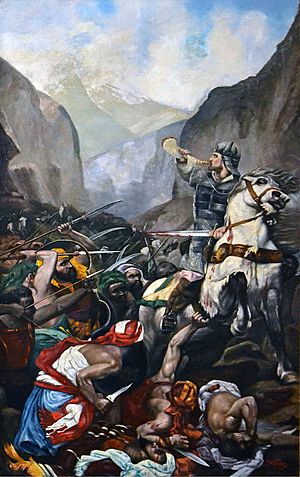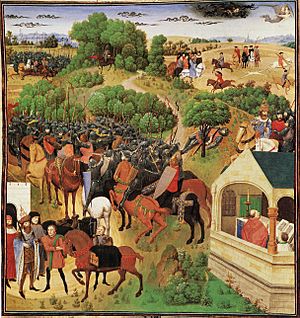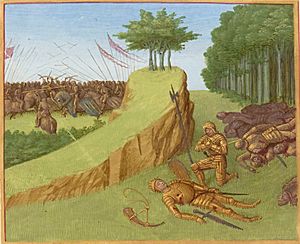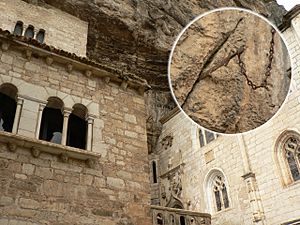Song of Roland facts for kids
The Song of Roland (in French, La Chanson de Roland) is a famous poem from the 11th century. It tells the story of a brave Frankish leader named Roland. The poem is based on a real battle that happened in AD 778. This battle involved Charlemagne, a powerful king.
The Song of Roland is the oldest major French story that we still have today. Many copies of it were made, showing how popular it was for hundreds of years. It is a type of poem called a chanson de geste. These poems were popular in Europe between the 11th and 16th centuries. They told stories about heroic deeds and legends.
Contents
What is The Song of Roland?
The Song of Roland is an epic poem. This means it's a long story about heroes and their adventures. It was written in Old French, an early form of the French language. Experts believe it was written between 1040 AD and 1115 AD. The final poem has about 4,000 lines of poetry.
How Old is the Poem?
Even though the story is about events from the 700s, the poem was written much later. The most famous copy of The Song of Roland is at the Bodleian Library in Oxford, England. This copy was made between 1129 and 1165. It was written in Anglo-Norman, a language used in England after the Norman Conquest.
Scholars think a poet named Turold might have written the poem. Many changes and additions were likely made to it over time. Some believe the poem was influenced by wars in Spain in the 1030s. Others think it might have been changed after the First Crusade began in 1096.
The poem mentions a term, d'oltre mer, which means "overseas" or "beyond the sea." This term was used to describe Muslim lands. It was also used to talk about the Middle East during the Crusades. However, the way it's used in the poem suggests it was written before the Crusades started.
The Song of Roland became known as France's national epic. This happened after two old copies were found in the 1830s. A full version was then published in 1837.
The Story of Roland

The poem's story of the Battle of Roncesvalles is different from what historians know. Real history says that Basques attacked Charlemagne's army. They were angry because Charlemagne's army had looted a city called Pamplona. The poem, however, tells a different, more dramatic version.
Charlemagne's War in Spain
The story begins with Charlemagne's army fighting Muslims in Spain. They have been fighting for seven years. The last city still standing is Saragossa, ruled by the Muslim King Marsile. King Marsile is afraid of Charlemagne's powerful army.
Marsile's wise advisor, Blancandrin, tells him to make peace. He suggests offering Charlemagne treasures and hostages. Marsile also promises to become a Christian if the Franks leave Spain. Charlemagne and his men are tired of fighting, so they agree to this peace offer.
Ganelon's Betrayal
Charlemagne needs to send a messenger to Marsile's court. Roland, Charlemagne's brave nephew, suggests his stepfather, Ganelon, for this dangerous job. Ganelon is angry. He fears Marsile will kill him and thinks Roland chose him on purpose.
To get revenge, Ganelon secretly tells the Saracens how to attack Charlemagne's army. He explains they should ambush the rear guard. This is the part of the army that marches at the very back. Roland will be leading it.
The Battle of Roncesvalles
As Ganelon planned, Roland leads the rear guard. With him are his wise friend Oliver and the brave Archbishop Turpin. The Muslims attack them at a place called Roncesvalles. The Christian soldiers are greatly outnumbered.
Oliver begs Roland to blow his horn, called an olifant. This would call Charlemagne's main army back for help. But Roland refuses, saying it would be cowardly to ask for help in battle. Oliver even threatens not to let Roland see his sister, whom Roland loves.
Archbishop Turpin steps in. He tells Roland that they will all die in this battle. He says Roland should blow his olifant to call for revenge. Roland blows the horn with such force that his temples bleed. Charlemagne hears the call as he rides back to Francia. Ganelon tries to trick Charlemagne, but the king and his noblemen gallop back.
The Franks fight bravely, but there are too many enemies. Almost all of Roland's men are killed. Roland knows Charlemagne's army cannot save them now. Still, he blows his olifant one last time to summon revenge. After more fighting, Roland dies from his wounds, like a hero. Angels take his soul to heaven.
Charlemagne's Revenge
When Charlemagne and his men arrive, they find all of Roland's men dead. They chase the Muslims to the Ebro river, where many drown. Meanwhile, a powerful Muslim leader named Baligant, the emir of Babylon, arrives to help Marsile.
Baligant's army meets Charlemagne's army at Roncesvalles. The Christians are burying their dead. The Franks fight fiercely. When Charlemagne kills Baligant, the Muslim army runs away. The Franks then conquer Saragossa. Charlemagne takes Marsile's wife, Bramimonde, back to his capital, Aix.
Ganelon's Punishment
The Franks discover Ganelon's betrayal. They keep him chained until his trial. Ganelon argues that his actions were fair revenge, not treason. At first, the council of lords is swayed by his words. They are also afraid of Ganelon's friend, Pinabel.
But one man, Thierry, argues against Ganelon. He says that because Roland was serving Charlemagne when Ganelon betrayed him, Ganelon's actions were treason. Pinabel challenges Thierry to a fight to the death. Thierry wins the fight, which is seen as a sign from God. This proves Ganelon's guilt.
Ganelon and thirty of his relatives are executed. Bramimonde, Marsile's wife, becomes a Christian and changes her name to Juliana. The story ends with Charlemagne being told by an angel to go help another king. He feels sad about his long life of fighting.
How the Poem is Written
The poem is written in sections called laisses. These sections have different lengths. Each line has ten syllables. There is a strong pause in the middle of each line. The last sound of each line in a laisse is the same. This is called assonance, not rhyming.
The Song of Roland uses a lot of repetition. It also shows contrasts between characters. For example, Roland suggests Ganelon for the dangerous mission. Then Ganelon suggests Roland lead the rear guard. Charlemagne is shown as the opposite of Baligant.
The poem focuses on what characters do, not what they think or feel. The narrator doesn't explain why characters act the way they do. The warriors are shown with just a few main traits. Roland is loyal, while Ganelon is brave but also a traitor.
The story moves quickly. Sometimes, the same scene is told up to three times. Each time, it focuses on different details or a new point of view. This is like a movie scene shot from different angles. It helps new and important details appear with each shot.
Main Characters
- Baligant: A powerful Muslim leader who comes to help King Marsile.
- Blancandrin: A wise pagan (non-Christian) who advises King Marsile.
- Bramimonde: King Marsile's wife, who becomes Christian after Saragossa falls.
- Charlemagne: The King of the Franks, leading his army against the Saracens. He carries a sword named Joyeuse.
- Ganelon: Roland's stepfather and a lord who betrays the French army. He carries a sword named Murgleis.
- King Marsile: The Muslim king of Spain. Roland wounds him, and he later dies.
- Naimon: Charlemagne's trusted advisor.
- Oliver: Roland's close friend. He is wise and is killed in battle.
- Roland: The hero of the story and Charlemagne's nephew. He leads the rear guard. He dies after blowing his olifant horn very hard. He carries a sword named Durandal.
- Turpin: An Archbishop who fights alongside Roland. He represents the Church's strength. He carries a sword named Almace.
Other Characters
- Aude: Roland's fiancée and Oliver's sister.
- Basan: A Frankish lord, killed while being a messenger to Marsile.
- Bérengier: One of the twelve brave knights killed by Marsile's troops.
- Besgun: Charlemagne's chief cook, who guards Ganelon after his betrayal.
- Geboin: A leader in Charlemagne's army.
- Godefroy: Charlemagne's standard bearer and Thierry's brother.
- Grandoyne: A strong fighter on Marsile's side, killed by Roland.
- Hamon: A commander in Charlemagne's army.
- Lorant: A Frankish commander, killed by Baligant.
- Milon: Guards the dead Frankish soldiers.
- Ogier: A Danish warrior who leads a part of Charlemagne's army.
- Othon: Guards the dead Frankish soldiers.
- Pinabel: Fights for Ganelon in the trial by combat.
- Thierry: Fights for Charlemagne in the trial by combat.
Durandal: Roland's Legendary Sword
In The Song of Roland, the amazing sword called Durandal was given to Charlemagne by an angel. This sword was said to be the sharpest in the world. It was also believed to hold special holy items. These included a tooth of Saint Peter, blood of Saint Basil, hair of Saint Denis, and a piece of clothing from the Virgin Mary.
In the story, Roland uses Durandal to fight many Muslim attackers by himself. A legend from the French town of Rocamadour says that Roland threw his sword into a cliffside. Today, you can see a copy of this legendary sword stuck in the cliff near the town's sanctuary.
Modern Versions and Influences
The Song of Roland has inspired many other stories, poems, and even operas.
- A Latin poem called Carmen de Prodicione Guenonis was written around 1120.
- A German version, Rolandslied, was translated around 1170.
- An Old Norse (Viking language) version exists in the Karlamagnús saga.
- In 1516, Ludovico Ariosto wrote an epic poem called Orlando Furioso. This story features many characters first seen in The Song of Roland. Roland's name is Orlando in Italian.
- There's a Faroese song called "Runtsivalstríðið" (Battle of Roncevaux).
- The opera Orlando Paladino (1782) by Joseph Haydn is based on the story.
- The book The Confidential Agent (1939) by Graham Greene mentions The Song of Roland a lot. The main character was a scholar who studied the poem.
- Stephen King's Dark Tower book series has a hero named Roland Deschain. This character is inspired by the poem.
- An animated short film called I paladini di Francia (1960) was made into a children's book. It was later published in English as Ronald and the Wizard Calico.
- In the 1994 video game Marathon, the main bad guy is named Durandal.
- In 2017, Michael Eging and Steve Arnold wrote a novel called The Silver Horn Echoes: A Song of Roland. It tells more of Roland's story before the battle.
- In 2019, the German folk rock band dArtagnan released a song called "Chanson de Roland."
See also
 In Spanish: Cantar de Roldán para niños
In Spanish: Cantar de Roldán para niños
- Roland's Breach
- Matter of France
- Lamprecht




